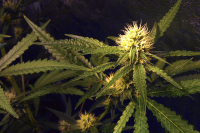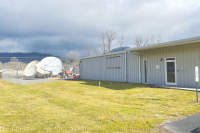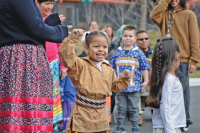Getting close to the food you eat
By Adam Bigelow • Guest Columnist
The morning chill had lifted, mist had risen into the air, and as I walked towards the waiting group I had no idea what to expect from this day. We were all here for the same purpose, and my apprehension had not dissolved with the mist. I was running late this morning and afraid that I had missed the event, but out of the corner of my eye I saw the guest of honor. Tied to a swing set. Awaiting his fate.
It’s been almost 10 months since I have eaten meat, and in that time I have embraced an environmentalist ideal of vegetarianism. My weight is down, my energy is up, and I have become more conscious of what I eat, where it comes from, how it is produced, and what effects it has on my body and my mind. I am getting all the funny looks, amazed questions and disbelieving sarcasms that I used to give to others who excluded meat from their diet. My sister, Tacy, went vegetarian years ago, and many of the experiences that she shared with me are occuring on an almost daily basis: the shock and wonder some folks have upon hearing that I don’t eat meat; the zeal with which some search a menu for foods that I can eat.
I strongly remember my sister slamming her chain restaurant menu closed and stating defiantly, “I know how to read a freakin’ menu” after the whole family had made attempts to assuage our own guilt at being able to choose any item (meatless or not) by pointing out to my vegetarian sister, her options on this menu. “Ooh, you can eat mashed potatoes.” I also remember the excitement that the family all shared the first time we saw a real-life “Tofurky” and how in our attempt to make it seem not-weird we all wanted to sample it, and that we had to be reminded that there was an animal turkey for the omnivores at the table to eat.
I am approaching my first meatless holiday season, contemplating Tofurky and gravy with all the trimmings, and wondering how I could have survived all this time on a diet of mostly soda, candy, and chips. I grew up in Hampton, Va., completely disassociated from food and where it came from. Candy and chocolate, ice cream and cake, and gallon after gallon of soda were all mainstays in my diet. The only vegetables that I ate were corn, and canned green beans. My fast-food cheeseburgers always took a long time, as I had to have them specially made without the pickles, onions, and mustard. My favorite food was pizza and if I had my way, I would have eaten pizza for every meal.
This wish was later granted in my long tenure as a pizza maker, working in restaurant after restaurant, being poorly paid but well fed in a constant, all-you-can-eat pizza buffet version of life. I remember gardens in my neighborhood, but as far as I knew, “food” came from the refrigerator, the grocery store, or the waitress.
Related Items
Now I am an organic gardener participating in our small-town community garden. I have been studying horticulture and biology, and I find myself thinking about food all the time. I have spent a lot of time around food, working in restaraunts and hanging out with “food people” and other restaurant workers. Yet, I find that I am still distant from the production of most of my food. Although I know Joe and Annie and the gang down at Annies Naturally Bakery, where all of my delicious bread comes from, I have never helped bake it, nor have I grown and threshed wheat. I frequent the Mad Batter in Cullowhee, and Bubaczs’ Underground in Downtown Sylva for coffee and lunch, yet I have never even seen a coffee plantation. And as much as I can without it becoming embarrassing, I eat dinner at Guadalupe Café, my favorite restaurant.
Now I know Jeanette, John, and Jen and I support their respective establishments for a number of reasons including the political, health, and social issues that are wrapped up in food choices. Yet I find myself wondering if I would be able to become independent from all extraneous food sources and produce my own sustenance. Probably not, and I fear that if we had to fend for ourselves, we might all be in trouble.
So, in a continuing attempt at connecting more closely with food, I found myself a few weeks ago accepting an invitation to dine with some friends who were going to slaughter, prepare, and cook a goat. Now to those farm children who grew up with pigs and chickens, cows and goats, this all might sound a little ridiculous: “city boy gonna kill him a goat.” And I understand, it seems ridiculous to me too, especially as a vegetarian city-boy.
But what seems even more ridiculous to me is that my only experience with meat is as a pre-packaged, shrink-wrapped, boneless, skinless, lifeless cut of steak, pork, or chicken. And further that I am not alone, but standing with a majority of Americans who are disconnected from food. The people hosting this event are very connected with their food, growing not only organic vegetables, but also chickens, ducks and rabbits on the land that they live off of. So this was not such an isolated event for them. But for many in the group, this would be our first time taking a living, breathing animal from knife to table.
As we approached our meal, still as tied to its fate as it was to the swing set, quiet swept over our group. A silence settled that is normally associated with church, reminding me that in ancient times food preparation was very much entwined with religious ceremony. The goat resisted, and was forceably held down as the left side of its throat was slit. Shortly thereafter, seemingly an eternity, the last breath of this animal escaped its lungs and it died. The silence persisted, and I do believe that some prayers of thanksgiving were said under muted breath.
I placed my hand on its hide and felt that last breath, expecting remorse, or sadness. I felt neither. Many of the ideas that I had built up in my mind about watching an event like this did not hold true. I felt no remorse, or disgust, or guilt at being involved — it all felt rather natural. I was merely engaging in something that used to be an everyday occurance. I was simply preparing food, not much different from what I did at home and at work for so long, except that in the restaurant, the vestigal signs of life have been removed. We hung the carcass (begin the parade of euphemisms) on the swing set bars and watched as the last of the blood was drained.
Skinning the goat took a learned skill in order to be able to use both the pelt and the meat from the animal. This is where I joined in and got my hands dirty, helping to extricate the skin and fur fom the rest of the body. With the skin gone, the goat began to take on a more food-like appearance. The internal organs were removed rather quickly (gravity helped), and with the addition of a few cloves of garlic the meat was ready to be cooked. A pit had been dug earlier and a large fire was built in it. We wrapped the goat in aluminum foil, and placed it in the coals, and for the first time in my life I had helped slaughter an animal.
I still don’t know how I feel about meat, and I am still eating a vegetarian diet even though I sampled the goat meat. I wanted to eat the goat to help close the circle on the day, and out of respect for the animal that had given its life to help me understand food more intimately. It was the first meat that I had eaten in a long time, so I ate sparingly. It was good. The taste was reminiscent of steak and pork, but unlike either. The texture was chewy, what I suppose most people are referring to when they mention that ‘gamey’ flavor I have heard so much about over the years.
As I chewed the proffered piece and contemplated filling my belly on the meat we were all sharing, the festive nature of the gathering sobered me. I thought myself immune from ideas of moral apprehension towards meat eating. I am intellectually aware that life is created and consumed all around me. From the mites that live in our eyebrows, yes yours too, to the microbal life that is killed every time I turn another spade full of dirt, none of us can escape death or killing. A friend of mine emphasized that the intent behind an action is the discernment between death and murder, and I agree.
However, when the intent is survival and food, then all bets are off. The idea that I was attending a goat-slaughter party made me realize that I am not comfortable with eating meat, that I was not feeling good about this connection that I had made with food. That I was not a carnivore.
(Adam Bigelow is a resident of downtown Sylva, a gardener at the Community Garden, and a member of the local music scene. He is currently attending WCU, studying Environmental Science and Biology. He can be reached at This email address is being protected from spambots. You need JavaScript enabled to view it..)









